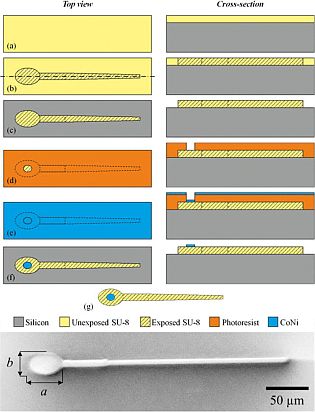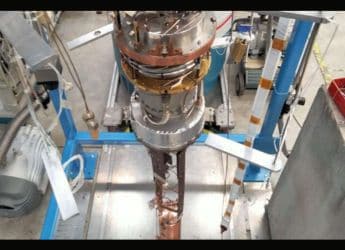- Home
- Science
- Science News
- Researchers Develop Sperm Inspired Robots Controlled by Magnetic Fields
Researchers Develop Sperm-Inspired Robots Controlled by Magnetic Fields

Scientists, including one of Indian-origin, have developed sperm-inspired robots controlled by magnetic fields that may be useful for drug delivery, IVF and other applications at the microscopic level.
A team of researchers at the University of Twente in Netherlands and German University in Cairo developed the microrobots which can be controlled by oscillating weak magnetic fields.
The 322 micron-long robots consist solely of a head coated in a thick cobalt-nickel layer and an uncoated tail.
When the robot is subjected to an oscillating field of less than five millitesla - about the strength of a decorative refrigerator magnet - it experiences a magnetic torque on its head, which causes its flagellum to oscillate and propel it forward. The researchers are then able to steer the robot by directing the magnetic field lines towards a reference point.
Islam Khalil designed the MagnetoSperm microrobots along with Sarthak Misra and colleagues at MIRA-Institute for Biomedical Technology and Technical Medicine at the University of Twente.
"Nature has designed efficient tools for locomotion at micro-scales. Our microrobots are either inspired from nature or directly use living micro-organisms such as magnetotactic bacteria and sperm cells for complex micro-manipulation and targeted therapy tasks," said Misra, principal investigator of this study, and an associate professor at the University of Twente.
"As technology progresses and many products get smaller, it becomes difficult to assemble objects on nano- and micro-scales," said Khalil, an assistant professor at the German University in Cairo.
"MagnetoSperm can be used to manipulate and assemble objects at these scales using an external source of magnetic field to control its motion," Khalil added.
In addition to nano-assembly, the radical downsizing afforded by the offloading of power and navigation systems opens up a wide range of biomedical tasks that MagnetoSperm can perform, Khalil said.
These include targeted drug delivery, in vitro fertilisation, cell sorting and cleaning of clogged arteries, among others.
The microrobot was made by spin-coating onto a silicon support wafer a five-micron layer of SU-8, a polymer chosen for its ease of fabrication and mechanical stability.
The cobalt-nickel layer was then added to the head by use of electron beam evaporation.
The research appeared in the journal Applied Physics Letters, published by American Institute of Physics.
Catch the latest from the Consumer Electronics Show on Gadgets 360, at our CES 2026 hub.
Related Stories
- Samsung Galaxy Unpacked 2025
- ChatGPT
- Redmi Note 14 Pro+
- iPhone 16
- Apple Vision Pro
- Oneplus 12
- OnePlus Nord CE 3 Lite 5G
- iPhone 13
- Xiaomi 14 Pro
- Oppo Find N3
- Tecno Spark Go (2023)
- Realme V30
- Best Phones Under 25000
- Samsung Galaxy S24 Series
- Cryptocurrency
- iQoo 12
- Samsung Galaxy S24 Ultra
- Giottus
- Samsung Galaxy Z Flip 5
- Apple 'Scary Fast'
- Housefull 5
- GoPro Hero 12 Black Review
- Invincible Season 2
- JioGlass
- HD Ready TV
- Laptop Under 50000
- Smartwatch Under 10000
- Latest Mobile Phones
- Compare Phones
- OPPO Reno 15 Pro Max
- Honor Win RT
- Honor Win
- Xiaomi 17 Ultra Leica Edition
- Xiaomi 17 Ultra
- Huawei Nova 15
- Huawei Nova 15 Pro
- Huawei Nova 15 Ultra
- Asus ProArt P16
- MacBook Pro 14-inch (M5, 2025)
- OPPO Pad Air 5
- Huawei MatePad 11.5 (2026)
- Xiaomi Watch 5
- Huawei Watch 10th Anniversary Edition
- Acerpure Nitro Z Series 100-inch QLED TV
- Samsung 43 Inch LED Ultra HD (4K) Smart TV (UA43UE81AFULXL)
- Asus ROG Ally
- Nintendo Switch Lite
- Haier 1.6 Ton 5 Star Inverter Split AC (HSU19G-MZAID5BN-INV)
- Haier 1.6 Ton 5 Star Inverter Split AC (HSU19G-MZAIM5BN-INV)














